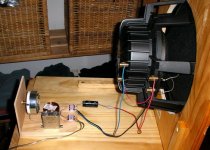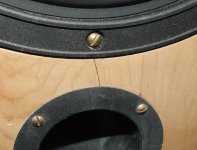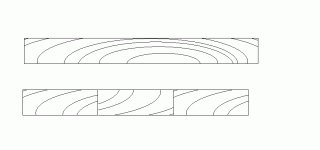leadbelly said:
I am just so tired of watching you drown out the opinions of other knowledgable woodworkers by your tireless spamming.
Add me your ignore list.
adason said:open baffle coax
You likem da Sammi's? Still using a simple cap on the tweet? Mine still in box until something else breaks. Yours look great.
You likem da Sammi's? Still using a simple cap on the tweet?
I love them, as you know looking at yours, they are well built, highly efficient, nothing to complain about. Cheap man's Altecs. Yes, I still have just a cap and L pad for the tweeter. You have to brink the tweeter down to 1/3 of the signal. Otherwise they love the power, they are not affraid to be cranked up from time to time (unlike my Lowthers). Sammi's are a good value, no regrets. You should put yours to good use!
pinkmouse said:It's not the glue joint that fails, it's the timber.
If the glue has enough give after curing, it will prevent the timber from failing.
pinkmouse said:And as for moisture selecting your timber, that only works if the piece is kept in controlled humidity conditions, such as a permanently air-conditioned office building.
My experience is different, and therefore I question if people are speaking from experience and have had these cross grain failures or just regurgitate what they were taught. I understand the technical reasons for your concern, but frankly, all I seem to hear in this thread is reasons to build cabinets designed for 50 year lifespans for speakers that are lucky if they are used 5 years by the owner.
leadbelly said:...My experience is different, and therefore I question if people are speaking from experience and have had these cross grain failures ...
Yes, and here's a pic to prove it.
Attachments
I also have had failures of this type, (no pics, sorry),
but not since I actually started considering methods to avoid it, it just requires a bit of thought and understanding of the differential shinkages an movements of timbers along and across the grain.
If you choose to build it purely out of flat pieces of hardwood, joined together tightly at all joints, you really are taking the risk !!
but not since I actually started considering methods to avoid it, it just requires a bit of thought and understanding of the differential shinkages an movements of timbers along and across the grain.
If you choose to build it purely out of flat pieces of hardwood, joined together tightly at all joints, you really are taking the risk !!
pinkmouse said:Yes, and here's a pic to prove it.
You sure? It seems to line up pretty well with that driver screw hole. 🙂
Well, about a dozen applications of oil when built, and a coat of wax every year or so, (so that's about half a dozen of those). I think that counts as finishing! 😉
my last comments
1. there is a risk
2. there are ways of minimising the risks.
3. your choice whether you choose to "think" or to "hope"!!
1. there is a risk
2. there are ways of minimising the risks.
3. your choice whether you choose to "think" or to "hope"!!

leadbelly said:
My experience is different, and therefore I question if people are speaking from experience and have had these cross grain failures or just regurgitate what they were taught. I understand the technical reasons for your concern, but frankly, all I seem to hear in this thread is reasons to build cabinets designed for 50 year lifespans for speakers that are lucky if they are used 5 years by the owner.
Hi,
It is one of the most basic rules of carpentry and joinery we are talking about here. The expansion and contraction of solid wood across the grain cannot be halted. Even when it is at EMC (equilibrium moisture content) and properly finished on all sides, there is still potential for movement.
When you use very dry wood, and keep the panel small, it will most likely never show signs of failure. This would be the case for the small boxes in your picture posted above.
But in a bigger box, possibly using wood that is not as dry as it should be, the chance of failure is much greater.
Solid wood at retail prices is quite expensive, and when it's your intention to build a "furniture grade" speaker cabinet, your preference would be for it to look good for more than 5 years.
I suggested a compromise earlier - use the solid wood for the sides, top and bottom, and veneered plywood for the back and front. Once it's done, the only one who will know the difference will be the builder.
The best of both worlds.
Have heard from several others outside of diyaudio, that you can minimize problems by gluing small pieces of less than 4-5 inches together. Dunno if its true. Seems similar to what plywood or chipboard is when you think about it.
I have a red oak speaker that's a open-back cabinet and its fine after 3 years. I did coat it on the inside and outside surfaces and it had been drying for many years naturally.
My next speaker will be plywood, however.
I have a red oak speaker that's a open-back cabinet and its fine after 3 years. I did coat it on the inside and outside surfaces and it had been drying for many years naturally.
My next speaker will be plywood, however.
Daveis said:Have heard from several others outside of diyaudio, that you can minimize problems by gluing small pieces of less than 4-5 inches together. Dunno if its true. Seems similar to what plywood or chipboard is when you think about it.
Laminating strips of lumber adds stability - the resulting "board" will stay flat, and resist warping. This does nothing for cross-grain expansion/contraction.
Attachments
pinkmouse said:
Yes, and here's a pic to prove it.
That was one of my thots, but Murphy tends to have the screw driver go the other way...
PM are those yours... say after me "slot screws go in the recycle bin..."
Do you need a box of real screws?
dave
I have plenty of Philips, pozi, and Torx headed screws and I wouldn't use anything else for construction, but the slot heads were an aesthetic decision. Oh, and you're quite correct, slot heads do need much more care to avoid the screwdriver slipping and damaging the surround. 😉
Daveis said:Have heard from several others outside of diyaudio, that you can minimize problems by gluing small pieces of less than 4-5 inches together. Dunno if its true. Seems similar to what plywood or chipboard is when you think about it.
that is exactly how these were made. many lengths of 3cm square timber glued side by side.
The base is 1" mdf, because I ran out of timber, but the rest is real timber!. The pods are turned out of solid mahogany.
http://members.optusnet.com.au/~gradds55/sauron2.jpg
MJL21193 said:Laminating strips of lumber adds stability - the resulting "board" will stay flat, and resist warping. This does nothing for cross-grain expansion/contraction.
I'm not a woodworker or carpenter, but would like to share my experience with wood.
In the past 9 years I've moved, along with my furniture, from an extreme tropical monsoon climate, to a continental climate, to a desert climate, to a mixed continental/monsoon climate. Most furniture has suffered, badly. As in 2 inch cracks in some, hairlines in the other -- oak, teak, pine etc etc -- and even stuff that is antique European oak (as in well and truly seasoned). This means that about a year after each move, some big furniture resoration is in order.
The only wood that has not suffered is various ply, and the laminated strip pinewood Ikea table tops.
A bit of an extreme example perhaps, as your speakers may not be moving climates and continents. But still, I would tend to agree that for speaker purposes solid wood is ideal.
On the other hand, I think ply, when finished well with the oil/lacquer/wax of your choice, can actually look very very nice.
🙂
DougL said:
Look closely at a "Tall drawers ". What you will see is the back floats. You will see that the top is not attached with glue, but some mechanical fasteners with some float. The Side panels are made with the main panel floating in a frame.
All in all, you will see several very sophisticated mechanisms used so that the chest can be "solid". The point is that none of these techniques are appropriate for a speaker box.
Doug
Edited to add Double Negative
Edited to remove Double Negative
I don't know what drawers you are looking at, but the ones I'm looking at are ones I've built. Maybe in commercial cabinetry that is the case, but I'm talking cherry dovetail drawers that are tall. Floating paenls that you speak of nowhere to be found in construction. No cracks yet, maybe I've figured out the secret. Then again, I am one of the few willing to admit their expeirence.
ML12...whatever. I've read some of your woodworking responses. While I agree with some of what you say, I disagree here and for you to say my lack of experience is showing through because I disagree with you just shows how inexperienced you really are. I have example after example of things that haven't cracked. Your "it's not a speaker box" doesn't hold any water for me.
I'll be you have never even tried a lacquer finish. You probably stick with oils and waxes. Cause they are better and don't really require any knowledge to get right.
There are a lot of people that are here solely because of speaker building and try to talk woodworking like they have real knowledge of it. It's funny.
- Status
- Not open for further replies.
- Home
- Loudspeakers
- Multi-Way
- Solid oak speakers???


